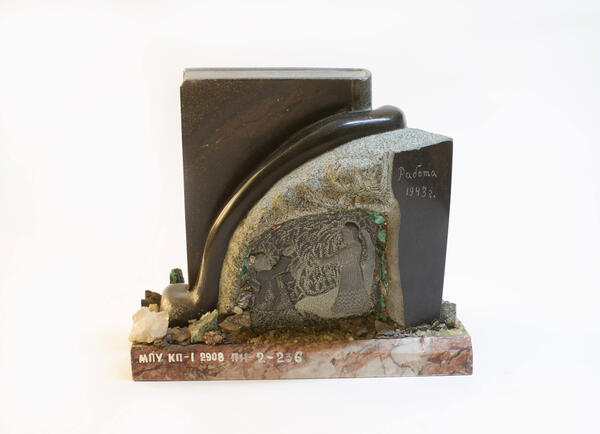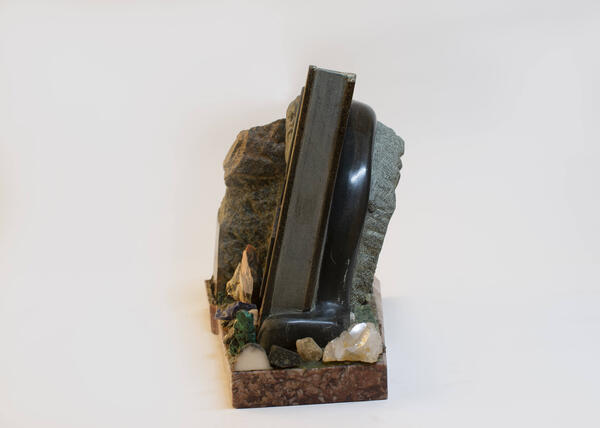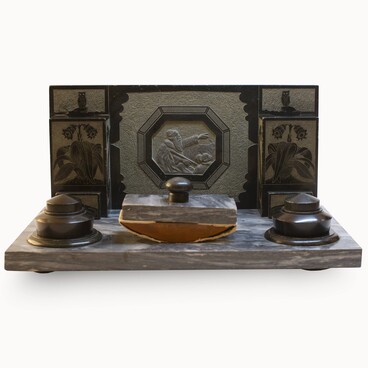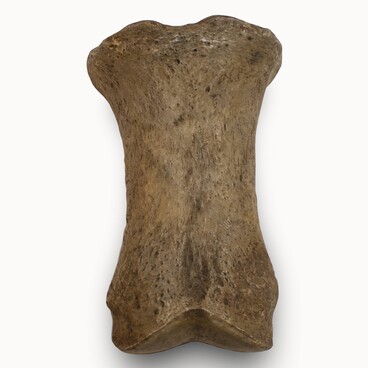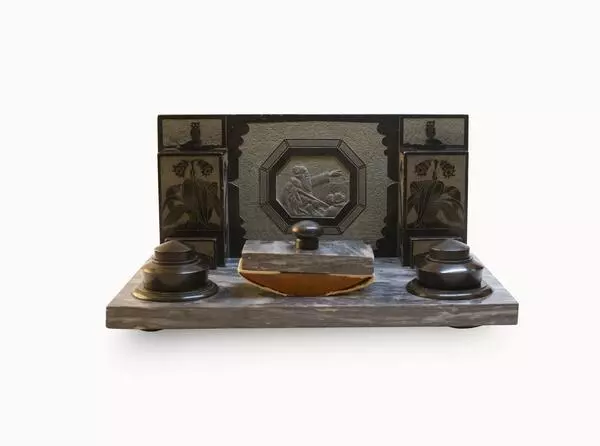“The Malachite Casket” is a collection of tales by the Ural writer Pavel Petrovich Bazhov. The tales published from 1936 to 1951 have been translated into more than 60 languages of the world. They inspired many feature and animated films, musicals, operas and ballets, as well as other types of musical, visual, decorative and applied artworks.
The stone book “The Malachite Casket” was one of several gifts made by the stone-cutter Karp Sergeyevich Averkiev for the Ural writer. The souvenir was made in 1943. That year, Pavel Petrovich Bazhov was awarded the Stalin Prize of the 2nd degree for this collection.
The composition is designed to look like a book of tales embedded into a block of rock. A serpent encircles the block — it is the Great Snake. The base is made of red marble and decorated with colored stones: amethyst, rhodonite, malachite, lapis lazuli and others.
Judging by the design, the stone-cutter depicted the first edition of the tales “The Malachite Casket” of 1939. The top of the cover features a bas-relief image of Bazhov, and the bottom part — grandfather Slyshko with the boys on Mount Dumnaya (one of the most common images in decorative and applied art in general and in Karp Averkiev’s art in particular). Between them is a conventional autograph of the writer.
The entire book is made of serpentine of various colors. Dark glossy shades, light matte and unusual brown tones make up the background of the cover. To create this coloring, serpentine was fired so that golden sparkles inside the stone became visible.
On the reverse side of the sculpture, as if inside a rock, another episode is engraved — the Mistress of the Copper Mountain turns the cruel clerk Severian into a rock. This episode is from the tale “The Manager’s Boot-Soles”, which was included in the very first edition of Pavel Petrovich Bazhov’s collection. The whole scene is framed by small pieces of malachite, pyrite and other small stones.
During his lifetime, Karp Sergeyevich Averkiev created many lapidary works inspired by the writings of the Ural writer: vases, boxes, pencil cases, ink sets, photo frames, and bas-reliefs. In addition, he supervised the creation of large sculptures cut from stone, which are also presented in the museum.
The stone book “The Malachite Casket” was one of several gifts made by the stone-cutter Karp Sergeyevich Averkiev for the Ural writer. The souvenir was made in 1943. That year, Pavel Petrovich Bazhov was awarded the Stalin Prize of the 2nd degree for this collection.
The composition is designed to look like a book of tales embedded into a block of rock. A serpent encircles the block — it is the Great Snake. The base is made of red marble and decorated with colored stones: amethyst, rhodonite, malachite, lapis lazuli and others.
Judging by the design, the stone-cutter depicted the first edition of the tales “The Malachite Casket” of 1939. The top of the cover features a bas-relief image of Bazhov, and the bottom part — grandfather Slyshko with the boys on Mount Dumnaya (one of the most common images in decorative and applied art in general and in Karp Averkiev’s art in particular). Between them is a conventional autograph of the writer.
The entire book is made of serpentine of various colors. Dark glossy shades, light matte and unusual brown tones make up the background of the cover. To create this coloring, serpentine was fired so that golden sparkles inside the stone became visible.
On the reverse side of the sculpture, as if inside a rock, another episode is engraved — the Mistress of the Copper Mountain turns the cruel clerk Severian into a rock. This episode is from the tale “The Manager’s Boot-Soles”, which was included in the very first edition of Pavel Petrovich Bazhov’s collection. The whole scene is framed by small pieces of malachite, pyrite and other small stones.
During his lifetime, Karp Sergeyevich Averkiev created many lapidary works inspired by the writings of the Ural writer: vases, boxes, pencil cases, ink sets, photo frames, and bas-reliefs. In addition, he supervised the creation of large sculptures cut from stone, which are also presented in the museum.


